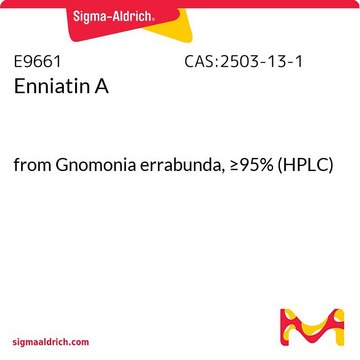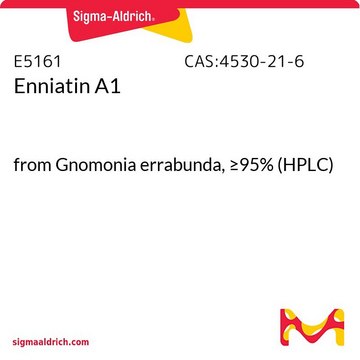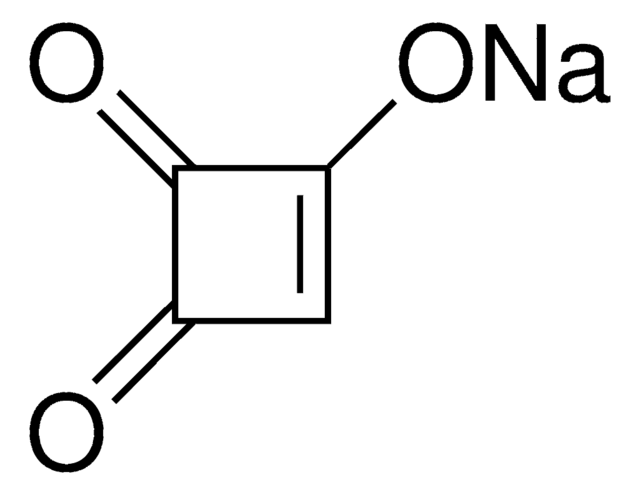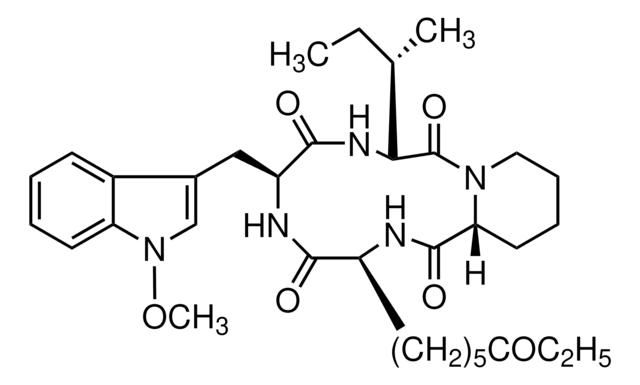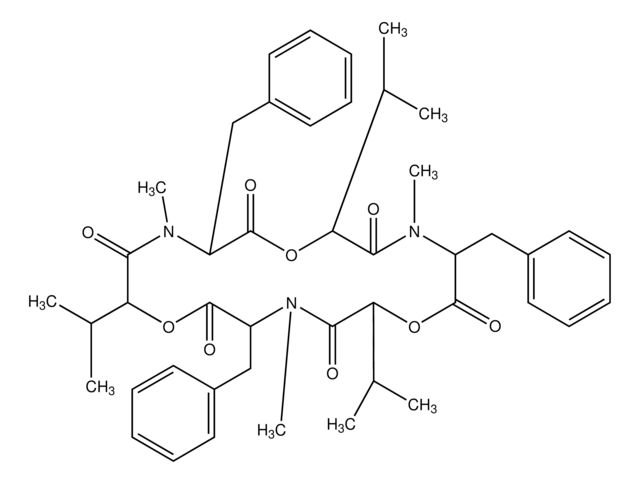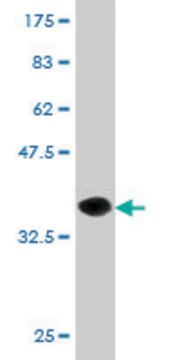E5286
Enniatin B1
from Gnomonia errabunda, ≥95% (HPLC)
Synonyme(s) :
2-(N-Methyl-L-isoleucine) Enniatin B, 3-Butan-2-yl-4,10,16-trimethyl-6,9,12,15,18-penta(propan-2-yl)-1,7,13-trioxa-4,10,16-triazacyclooctadecane-2,5,8,11,14,17-hexone
About This Item
Produits recommandés
Source biologique
Gnomonia errabunda
Niveau de qualité
Essai
≥95% (HPLC)
Solubilité
DMSO: 10 mg/mL
ethanol: 10 mg/mL
methanol: 10 mg/mL
Température de stockage
−20°C
Chaîne SMILES
N1(C(C(=O)OC(C(=O)N(C(C(=O)OC(C(=O)N(C(C(=O)OC(C1=O)C(C)C)C(C)C)C)C(C)C)C(C)C)C)C(C)C)C(CC)C)C
InChI
1S/C34H59N3O9/c1-16-22(12)25-34(43)46-27(20(8)9)30(39)36(14)23(17(2)3)32(41)44-26(19(6)7)29(38)35(13)24(18(4)5)33(42)45-28(21(10)11)31(40)37(25)15/h17-28H,16H2,1-15H3
Clé InChI
UQCSETXJXJTMKO-UHFFFAOYSA-N
1 of 4
Cet article | E5411 | E9661 | E5161 |
|---|---|---|---|
| Quality Level 200 | Quality Level 200 | Quality Level 200 | Quality Level 200 |
| storage temp. −20°C | storage temp. −20°C | storage temp. −20°C | storage temp. −20°C |
| solubility DMSO: 10 mg/mL, methanol: 10 mg/mL | solubility DMSO: 10 mg/mL, ethanol: 10 mg/mL, methanol: 10 mg/mL | solubility DMSO: 10 mg/mL, ethanol: 10 mg/mL, methanol: 10 mg/mL | solubility DMSO: 10 mg/mL, ethanol: 10 mg/mL, methanol: 10 mg/mL |
| biological source Gnomonia errabunda | biological source Gnomonia errabunda | biological source Gnomonia errabunda | biological source Gnomonia errabunda |
Application
Actions biochimiques/physiologiques
Mention d'avertissement
Danger
Mentions de danger
Conseils de prudence
Classification des risques
Acute Tox. 3 Dermal - Acute Tox. 3 Inhalation - Acute Tox. 3 Oral
Code de la classe de stockage
6.1C - Combustible acute toxic Cat.3 / toxic compounds or compounds which causing chronic effects
Classe de danger pour l'eau (WGK)
WGK 3
Point d'éclair (°F)
Not applicable
Point d'éclair (°C)
Not applicable
Faites votre choix parmi les versions les plus récentes :
Déjà en possession de ce produit ?
Retrouvez la documentation relative aux produits que vous avez récemment achetés dans la Bibliothèque de documents.
Les clients ont également consulté
Notre équipe de scientifiques dispose d'une expérience dans tous les secteurs de la recherche, notamment en sciences de la vie, science des matériaux, synthèse chimique, chromatographie, analyse et dans de nombreux autres domaines..
Contacter notre Service technique